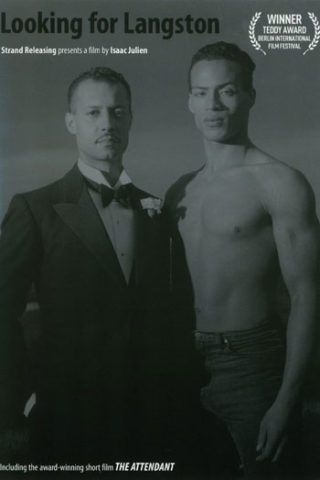
June 27, 2002.
I was unimpressed by Isaac Julien (1960–). Short and fat in a tan suit, he reminded me of Mobutu.
It did not help at all that his onstage interviewer, Susan Gearheart of the Bay Guardian, babbled on and on instead and that one ramble had no relation to the previous one, so that there was no development of a conversation. Julien showed no interest in what she was saying, though dutifully responding on the occasions she stopped. Interaction with the audience was limited to three questioners (four questions, but he ignored the extra one altogether).
 Julien reiterated that his partner Mark Nash, then teaching film studies at NYU, did research on the Harlem Renaissance, which IJ considered a precursor of the 1980s Black Arts Movement in England, and that he heard Toni Morrison’s speech at the memorial after James Baldwin’s death. He also talked to Essex Hemphill and met Blackberri in SF. In Waiting for Langston he sought to picture silence and in-between spaces that some call “the closet.” Had I not heard him say this, I would not have guessed it and found the short, repetitive film very pretentious and uninformative about Hughes and the Harlem Renaissance. (It did provide some black beefcake…)
Julien reiterated that his partner Mark Nash, then teaching film studies at NYU, did research on the Harlem Renaissance, which IJ considered a precursor of the 1980s Black Arts Movement in England, and that he heard Toni Morrison’s speech at the memorial after James Baldwin’s death. He also talked to Essex Hemphill and met Blackberri in SF. In Waiting for Langston he sought to picture silence and in-between spaces that some call “the closet.” Had I not heard him say this, I would not have guessed it and found the short, repetitive film very pretentious and uninformative about Hughes and the Harlem Renaissance. (It did provide some black beefcake…)
He reiterated that Young Soul Rebel was partly a story of growing up, as he did, in the East End of London during the 1970s with the music important to a combination buddy flick, murder mystery and vision of utopia. He did not speak to whether he is going to do another feature film.
He said that he did a thesis that was influenced by Fanon (at St. Marks Art School?) His (art schoolish) view of actors is that they tend to “get in the way of images,” so that he prefers to use nonactors.
 I thought that This is not an AIDS Advertisement was boring and visually negligible. Vagabonding was visually richer but totally inconsequential. Long Road to Mazatlan, shot in San Antonio, almost had a narrative, an opaque representation of cruising or at least lustful gazing and tussling.
I thought that This is not an AIDS Advertisement was boring and visually negligible. Vagabonding was visually richer but totally inconsequential. Long Road to Mazatlan, shot in San Antonio, almost had a narrative, an opaque representation of cruising or at least lustful gazing and tussling.
After he left (by which point half the audience that had half-filled the main floor of Herbst Theater had left), his new and conventional (i.e., not art schooly) documentary Baad Asssss Cinema redeemed the event with the demonstrative and outlandish (in dress and gestures) Quentin Tarrantino, clips from “blaxploitation” films of the early 1970s, and the NAACP/CORE/PUSH attacks on them, and impressively incisive interview footage of Samuel L. Jackson, Fred Williamson, and, especially, Pam Grier.
In general, I find Julien’s documentaries unsatisfyingly developed and so one sided as to be one dimentional, though there are always some interesting images in them.
Published by Culture Dose, 27 June 2002
©2002, 2016, Stephen O. Murray

